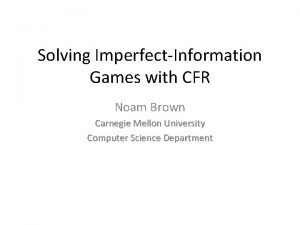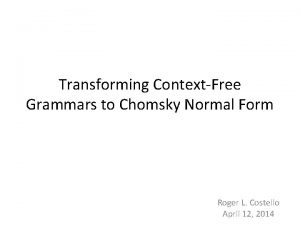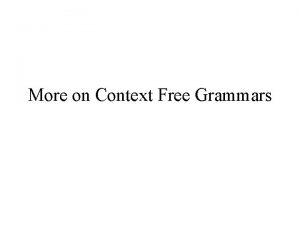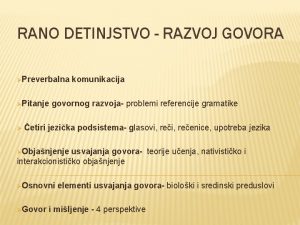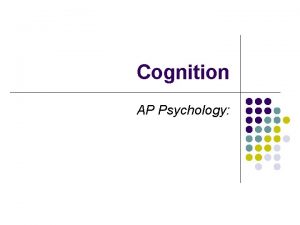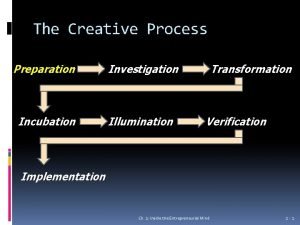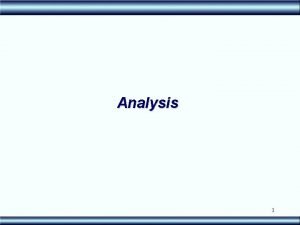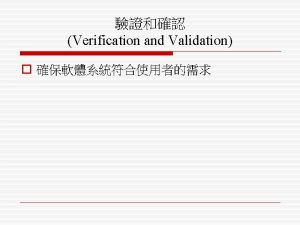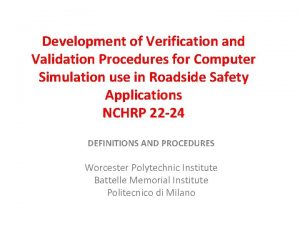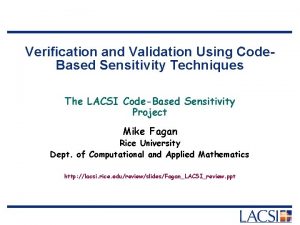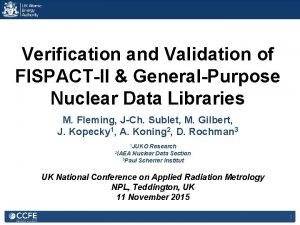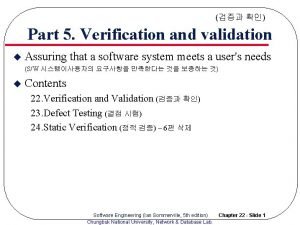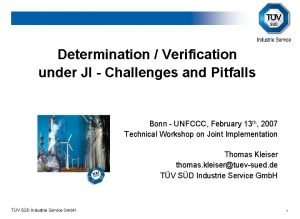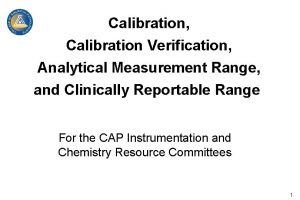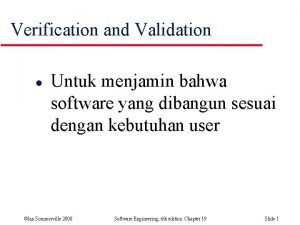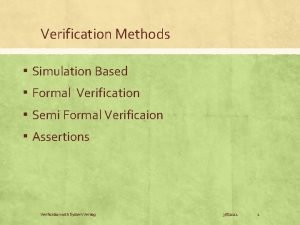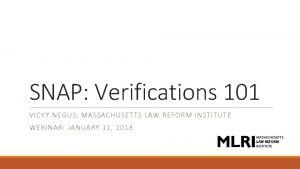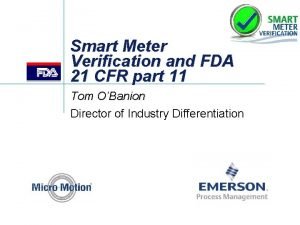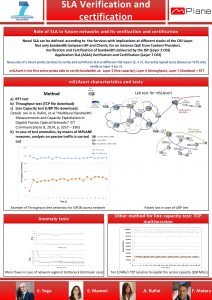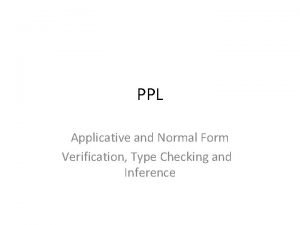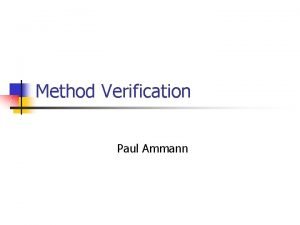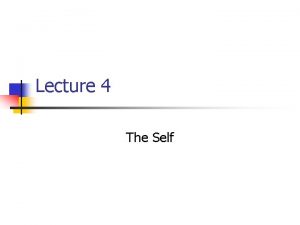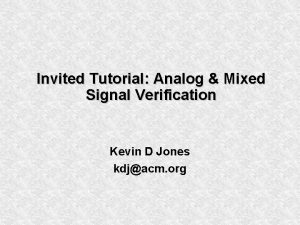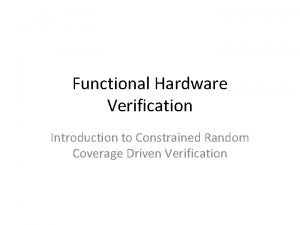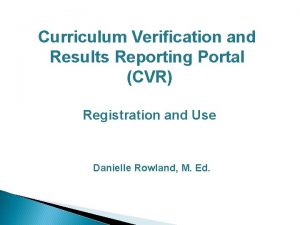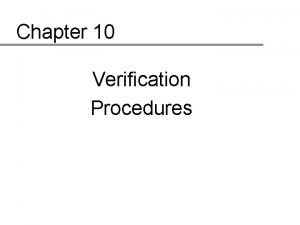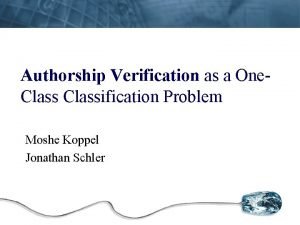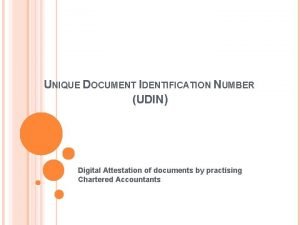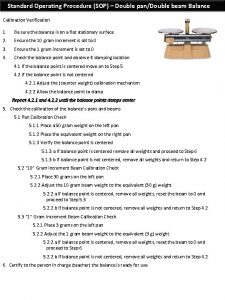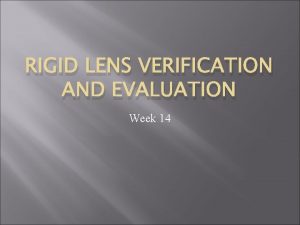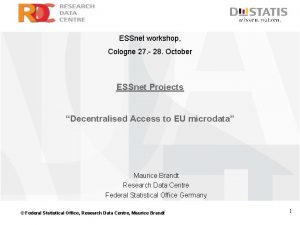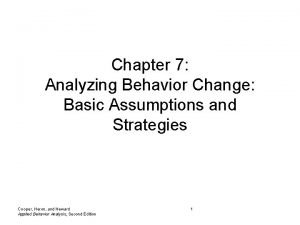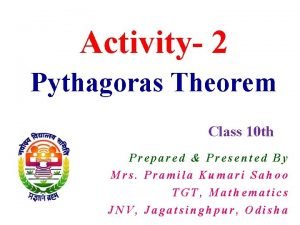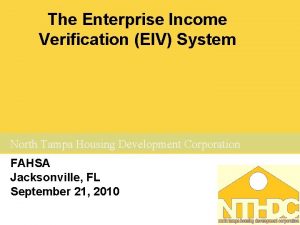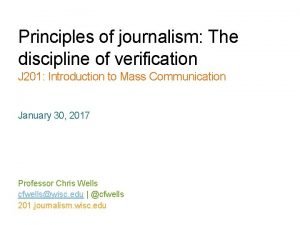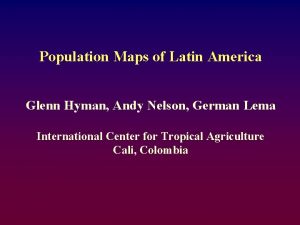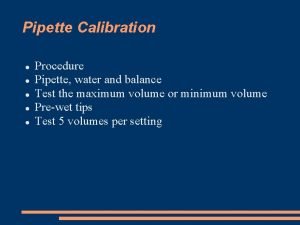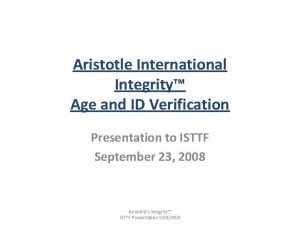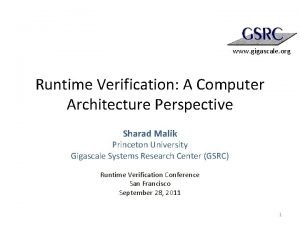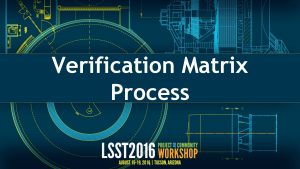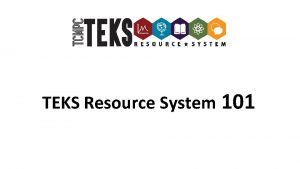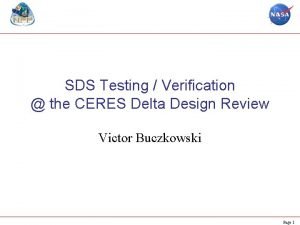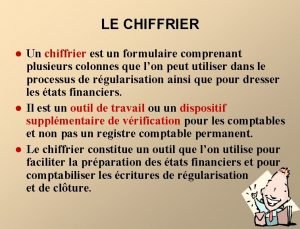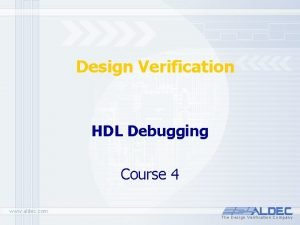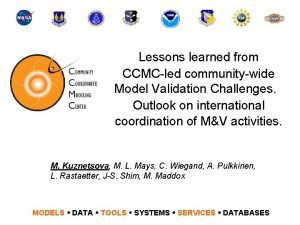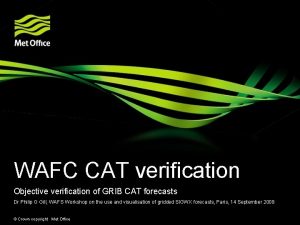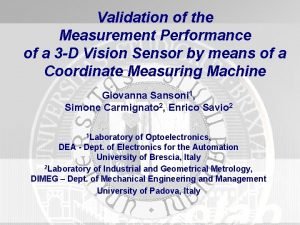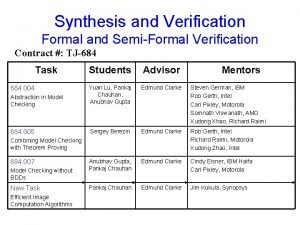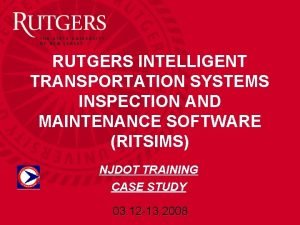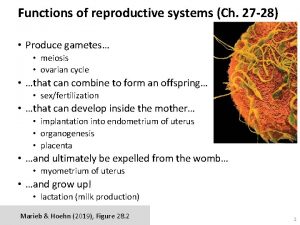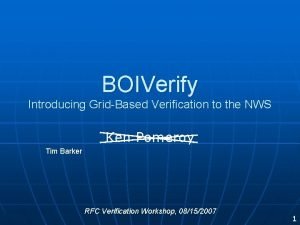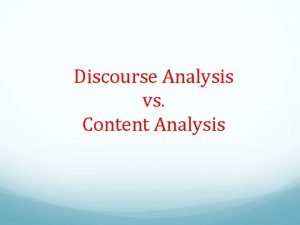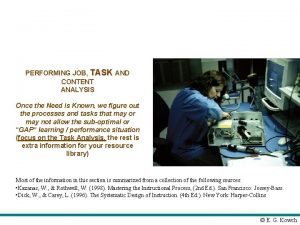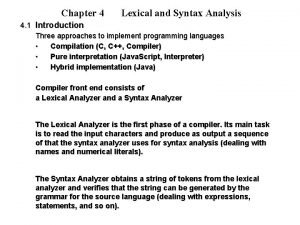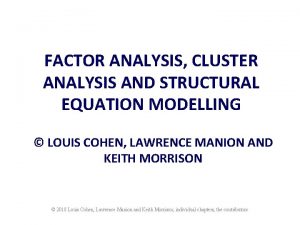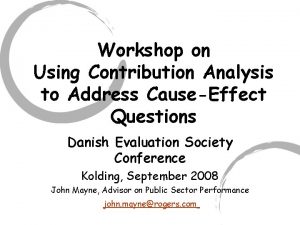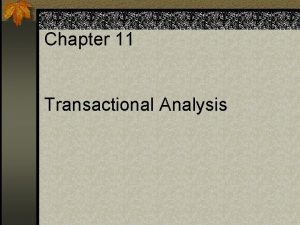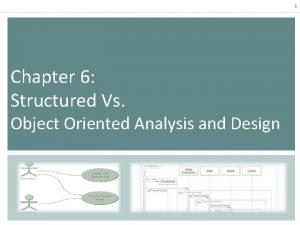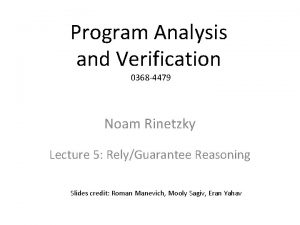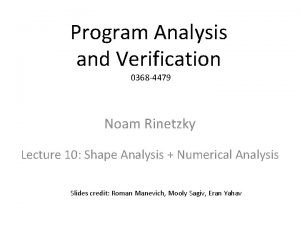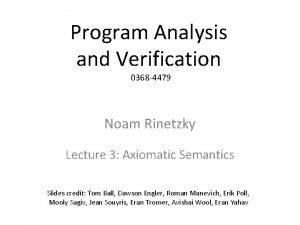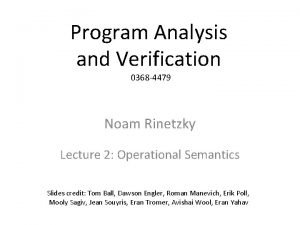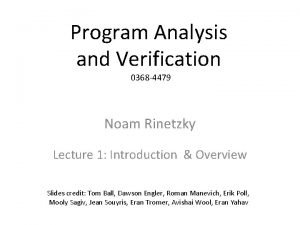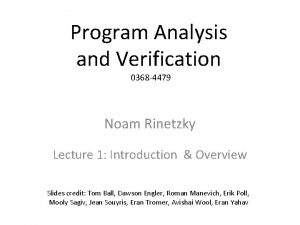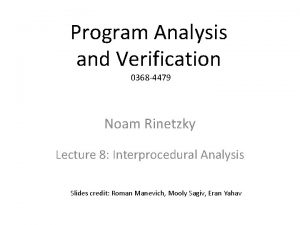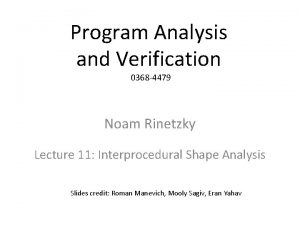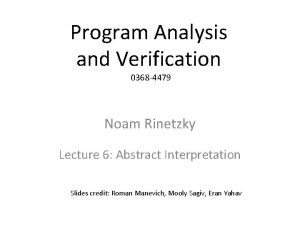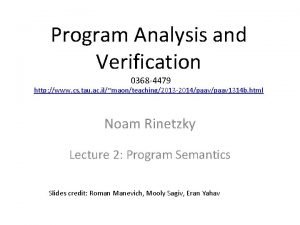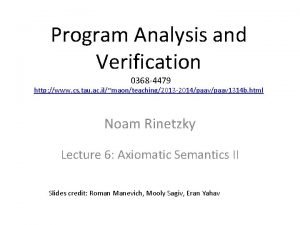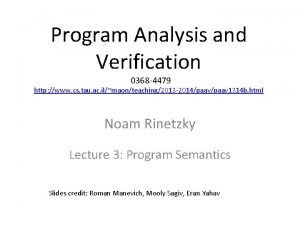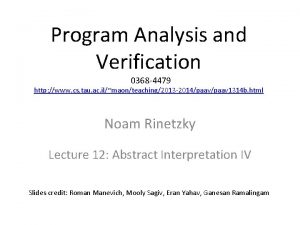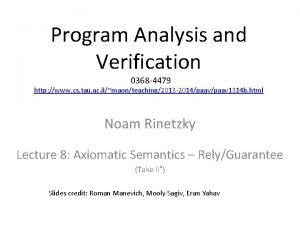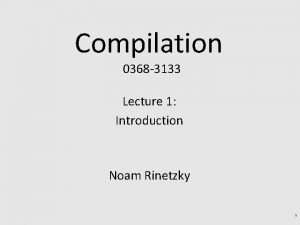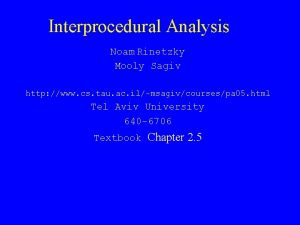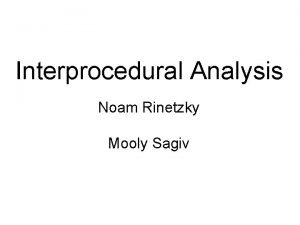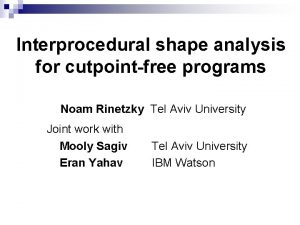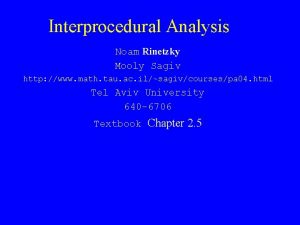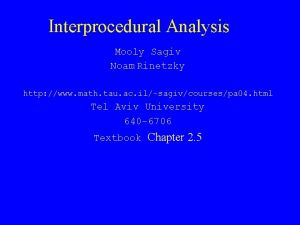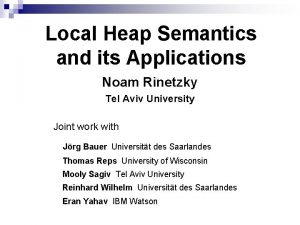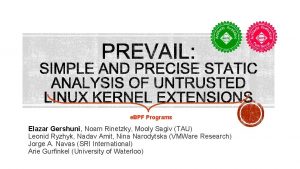Program Analysis and Verification 0368 4479 Noam Rinetzky

![Abstract Interpretation [Cousot’ 77] • Mathematical foundation of static analysis 2 Abstract Interpretation [Cousot’ 77] • Mathematical foundation of static analysis 2](https://slidetodoc.com/presentation_image_h/1246c149a26ade20bbdd92cf191ed6b8/image-2.jpg)











![Galois Connection: ( (a)) a C … [x� 6, y� 6, z� 6] [x� Galois Connection: ( (a)) a C … [x� 6, y� 6, z� 6] [x�](https://slidetodoc.com/presentation_image_h/1246c149a26ade20bbdd92cf191ed6b8/image-14.jpg)










![Best abstract transformer [CC’ 77] • Best in terms of precision – Most precise Best abstract transformer [CC’ 77] • Best in terms of precision – Most precise](https://slidetodoc.com/presentation_image_h/1246c149a26ade20bbdd92cf191ed6b8/image-25.jpg)






























![Points-to lattice • Points-to – PT-factoids[x] = { x=&y | y Var} �false PT[x] Points-to lattice • Points-to – PT-factoids[x] = { x=&y | y Var} �false PT[x]](https://slidetodoc.com/presentation_image_h/1246c149a26ade20bbdd92cf191ed6b8/image-56.jpg)
![Points-to lattice • Points-to – PT-factoids[x] = { x=&y | y Var} �false PT[x] Points-to lattice • Points-to – PT-factoids[x] = { x=&y | y Var} �false PT[x]](https://slidetodoc.com/presentation_image_h/1246c149a26ade20bbdd92cf191ed6b8/image-57.jpg)






![PWhile collecting semantics • CS[u] = set of concrete states that can reach program PWhile collecting semantics • CS[u] = set of concrete states that can reach program](https://slidetodoc.com/presentation_image_h/1246c149a26ade20bbdd92cf191ed6b8/image-64.jpg)











![Concrete transformers • • • CS[stmt] : State �x = y �s = s[x� Concrete transformers • • • CS[stmt] : State �x = y �s = s[x�](https://slidetodoc.com/presentation_image_h/1246c149a26ade20bbdd92cf191ed6b8/image-76.jpg)































![Intervals lattice for variable x • • Dint[x] = { (L, H) | L� Intervals lattice for variable x • • Dint[x] = { (L, H) | L�](https://slidetodoc.com/presentation_image_h/1246c149a26ade20bbdd92cf191ed6b8/image-108.jpg)
![Intervals lattice for variable x • • Dint[x] = { (L, H) | L� Intervals lattice for variable x • • Dint[x] = { (L, H) | L�](https://slidetodoc.com/presentation_image_h/1246c149a26ade20bbdd92cf191ed6b8/image-109.jpg)
![Joining/meeting intervals • [a, b] �[c, d] = ? – [1, 1] �[2, 2] Joining/meeting intervals • [a, b] �[c, d] = ? – [1, 1] �[2, 2]](https://slidetodoc.com/presentation_image_h/1246c149a26ade20bbdd92cf191ed6b8/image-110.jpg)
![Joining/meeting intervals • [a, b] �[c, d] = [min(a, c), max(b, d)] – [1, Joining/meeting intervals • [a, b] �[c, d] = [min(a, c), max(b, d)] – [1,](https://slidetodoc.com/presentation_image_h/1246c149a26ade20bbdd92cf191ed6b8/image-111.jpg)
![Interval domain for programs • Dint[x] = { (L, H) | L� -� , Interval domain for programs • Dint[x] = { (L, H) | L� -� ,](https://slidetodoc.com/presentation_image_h/1246c149a26ade20bbdd92cf191ed6b8/image-112.jpg)
![Interval domain for programs • • Dint[x] = { (L, H) | L� -� Interval domain for programs • • Dint[x] = { (L, H) | L� -�](https://slidetodoc.com/presentation_image_h/1246c149a26ade20bbdd92cf191ed6b8/image-113.jpg)
![Interval domain for programs • • Dint[x] = { (L, H) | L� -� Interval domain for programs • • Dint[x] = { (L, H) | L� -�](https://slidetodoc.com/presentation_image_h/1246c149a26ade20bbdd92cf191ed6b8/image-114.jpg)








![Fixed-point theorem [Kleene] • Let L = (D, � , � ) be a Fixed-point theorem [Kleene] • Let L = (D, � , � ) be a](https://slidetodoc.com/presentation_image_h/1246c149a26ade20bbdd92cf191ed6b8/image-123.jpg)


![Concrete semantics equations R[0] R[2] R[3] R[1] R[4] R[5] R[6] • R[0] = {x Concrete semantics equations R[0] R[2] R[3] R[1] R[4] R[5] R[6] • R[0] = {x](https://slidetodoc.com/presentation_image_h/1246c149a26ade20bbdd92cf191ed6b8/image-126.jpg)
![Abstract semantics equations R[0] R[2] R[3] R[1] R[4] R[5] R[6] • R[0] = ({x Abstract semantics equations R[0] R[2] R[3] R[1] R[4] R[5] R[6] • R[0] = ({x](https://slidetodoc.com/presentation_image_h/1246c149a26ade20bbdd92cf191ed6b8/image-127.jpg)
![Abstract semantics equations R[0] R[2] R[3] R[1] R[4] R[5] R[6] • R[0] = � Abstract semantics equations R[0] R[2] R[3] R[1] R[4] R[5] R[6] • R[0] = �](https://slidetodoc.com/presentation_image_h/1246c149a26ade20bbdd92cf191ed6b8/image-128.jpg)






![Widening for Intervals Analysis • [c, d] = [c, d] • [a, b] [c, Widening for Intervals Analysis • [c, d] = [c, d] • [a, b] [c,](https://slidetodoc.com/presentation_image_h/1246c149a26ade20bbdd92cf191ed6b8/image-135.jpg)
![Semantic equations with widening R[0] R[2] R[3] R[1] R[4] R[5] R[6] • R[0] = Semantic equations with widening R[0] R[2] R[3] R[1] R[4] R[5] R[6] • R[0] =](https://slidetodoc.com/presentation_image_h/1246c149a26ade20bbdd92cf191ed6b8/image-136.jpg)

![Non monotonicity of widening • [0, 1] [0, 2] = ? • [0, 2] Non monotonicity of widening • [0, 1] [0, 2] = ? • [0, 2]](https://slidetodoc.com/presentation_image_h/1246c149a26ade20bbdd92cf191ed6b8/image-138.jpg)
![Non monotonicity of widening • [0, 1] [0, 2] = [0, ] • [0, Non monotonicity of widening • [0, 1] [0, 2] = [0, ] • [0,](https://slidetodoc.com/presentation_image_h/1246c149a26ade20bbdd92cf191ed6b8/image-139.jpg)



![Narrowing for Interval Analysis • [a, b] = [a, b] • [a, b] [c, Narrowing for Interval Analysis • [a, b] = [a, b] • [a, b] [c,](https://slidetodoc.com/presentation_image_h/1246c149a26ade20bbdd92cf191ed6b8/image-143.jpg)
![Semantic equations with narrowing R[0] R[2] R[3] R[1] R[4] R[5] R[6] • R[0] = Semantic equations with narrowing R[0] R[2] R[3] R[1] R[4] R[5] R[6] • R[0] =](https://slidetodoc.com/presentation_image_h/1246c149a26ade20bbdd92cf191ed6b8/image-144.jpg)




- Slides: 148

Program Analysis and Verification 0368 -4479 Noam Rinetzky Lecture 5: Abstract Interpretation Slides credit: Roman Manevich, Mooly Sagiv, Eran Yahav
![Abstract Interpretation Cousot 77 Mathematical foundation of static analysis 2 Abstract Interpretation [Cousot’ 77] • Mathematical foundation of static analysis 2](https://slidetodoc.com/presentation_image_h/1246c149a26ade20bbdd92cf191ed6b8/image-2.jpg)
Abstract Interpretation [Cousot’ 77] • Mathematical foundation of static analysis 2

Required knowledge ü Collecting semantics ü Abstract semantics (over lattices) ü Algorithm to compute abstract semantics (chaotic iteration) • Connection between collecting semantics and abstract semantics • Abstract transformers 3

Recap • We defined a reference semantics – the collecting semantics • We defined an abstract semantics for a given lattice and abstract transformers • We defined an algorithm to compute abstract least fixed-point when transformers are monotone and lattice obeys ACC • Questions: 1. What is the connection between the two least fixedpoints? 2. Transformer monotonicity is required for termination – what should we require for correctness? 4

Recap • We defined a reference semantics – the collecting semantics • We defined an abstract semantics for a given lattice and abstract transformers • We defined an algorithm to compute abstract least fixed-point when transformers are monotone and lattice obeys ACC • Questions: 1. What is the connection between the two least fixedpoints? 2. Transformer monotonicity is required for termination – what should we require for correctness? 5

Galois Connection • Given two complete lattices C, � C) C = (DC, � – concrete domain A, � A) – abstract domain A = (DA, � • A Galois Connection (GC) is quadruple (C, , , A) that relates C and A via the monotone functions – The abstraction function : DC DA – The concretization function : DA DC • for every concrete element c DC and abstract element a DA ( (a)) a and c ( (c)) • Alternatively (c) �a iff c � (a) 6

Galois Connection: c ( (c)) C A The most precise (least) element in A representing c � ( (c)) 3 c 1 2 (c) 7

Galois Connection: ( (a)) a C What a represents in C (its meaning) A (a) 2 a � 1 ( (a)) 3 8

Example: lattice of equalities • Concrete lattice: C = (2 State, � , � , State) • Abstract lattice: EQ = { x=y | x, y Var} A = (2 EQ, � , � , EQ , � ) – Treat elements of A as both formulas and sets of constraints • Useful for copy propagation – a compiler optimization • (X) = ? (Y) = ? 9

Example: lattice of equalities • Concrete lattice: C = (2 State, � , � , State) • Abstract lattice: EQ = { x=y | x, y Var} A = (2 EQ, � , � , EQ , � ) – Treat elements of A as both formulas and sets of constraints • Useful for copy propagation – a compiler optimization • (s) = ({s}) = { x=y | s x = s y} that is s �x=y A { (s) | s X} (X) = � { (s) | s X} = � (Y) = { s | s �� Y } = models(� Y) 10

Galois Connection: c ( (c)) C x=x, y=y, z=z � 3 1 [x� 5, y� 5, z� 5] 4 � … [x� 6, y� 6, z� 6] [x� 5, y� 5, z� 5] [x� 4, y� 4, z� 4] … A x=x, y=y, z=z, x=y, y=x, 2 x=z, z=x, y=z, z=y The most precise (least) element in A representing [x� 5, y� 5, z� 5] 11

Most precise abstract representation (c) = � {c’ | c � (c’)} C A 6 � � 5 7 3 9 c 4 2 � 8 (c) 1 12

Most precise abstract representation (c) = � {c’ | c � (c’)} C A x=y � � 5 7 3 9 c 1 [x� 5, y� 5, z� 5] 6 x=y, z=y 4 2 x=y, y=z (c)= 8 x=x, y=y, z=z, x=y, y=x, x=z, z=x, y=z, z=y 13
![Galois Connection a a C x 6 y 6 z 6 x Galois Connection: ( (a)) a C … [x� 6, y� 6, z� 6] [x�](https://slidetodoc.com/presentation_image_h/1246c149a26ade20bbdd92cf191ed6b8/image-14.jpg)
Galois Connection: ( (a)) a C … [x� 6, y� 6, z� 6] [x� 5, y� 5, z� 5] [x� 4, y� 4, z� 4] … What a represents in C (its meaning) A 1 2 � x=y, y=z � is called a semantic reduction 3 x=x, y=y, z=z, x=y, y=x, x=z, z=x, y=z, z=y 14

Galois Insertion � a: ( (a))=a C How can we obtain a Galois Insertion from a Galois Connection? … [x� 6, y� 6, z� 6] [x� 5, y� 5, z� 5] [x� 4, y� 4, z� 4] … 2 A All elements are reduced 1 x=x, y=y, z=z, x=y, y=x, x=z, z=x, y=z, z=y 15

Properties of a Galois Connection • The abstraction and concretization functions uniquely determine each other: (a) = � {c | (c) �a} (c) = � {a | c � (a)} 16

Abstracting (disjunctive) sets • It is usually convenient to first define the abstraction of single elements (s) = ({s}) • Then lift the abstraction to sets of elements A { (s) | s X} (X) = � 17

The case of symbolic domains • An important class of abstract domains are symbolic domains – domains of formulas • C = (2 State, � , � , State) A, � A) A = (DA, � • If DA is a set of formulas then the abstraction of a state is defined as A{ | s � (s) = ({s}) = � } the least formula from DA that s satisfies • The abstraction of a set of states is A { (s) | s X} (X) = � • The concretization is ( ) = { s | s � } = models( ) 18

Inducing along the connections • Assume the complete lattices C, � C) C = (DC, � A, � A) A = (DA, � M, � M) M = (DM, � and Galois connections GCC, A=(C, C, A, C, A) and GCA, M=(A, A, M, A, M) • Lemma: both connections induce the GCC, M= (C, C, M, C, M) defined by C, M = C, A � A, M and M, C = M, A � A, C 19

Inducing along the connections C A A, C c’ 5 c 1 M M, A 4 C, A 2 C, A(c) A, M 3 a’ = A, M( C, A(c)) 20

Sound abstract transformer • Given two lattices C, � C) C = (DC, � A, � A) A = (DA, � and GCC, A=(C, , , A) with • A concrete transformer f : DC DC an abstract transformer f# : DA DA • We say that f# is a sound transformer (w. r. t. f) if • � c: f(c)=c’ (f#(c)) � (c’) • For every a and a’ such that A f#(a) (f( (a))) � 21

Transformer soundness condition 1 � c: f(c)=c’ (f#(c)) � (c’) A � C 5 1 f 2 3 f# 4 22

Transformer soundness condition 2 � a: f#(a)=a’ f( (a)) � (a’) C A f 3 � 4 5 1 f# 2 23

Best (induced) transformer f#(a)= (f( (a))) C f A 4 3 1 2 Problem: incomputable directly f# 24
![Best abstract transformer CC 77 Best in terms of precision Most precise Best abstract transformer [CC’ 77] • Best in terms of precision – Most precise](https://slidetodoc.com/presentation_image_h/1246c149a26ade20bbdd92cf191ed6b8/image-25.jpg)
Best abstract transformer [CC’ 77] • Best in terms of precision – Most precise abstract transformer – May be too expensive to compute • Constructively defined as f# = �f � – Induced by the GC • Not directly computable because first step is concretization • We often compromise for a “good enough” transformer – Useful tool: partial concretization 25

Transformer example • C = (2 State, � , � , State) • EQ = { x=y | x, y Var} A = (2 EQ, � , � , EQ , � ) • (s) = ({s}) = { x=y | s x = s y} that is s �x=y A { (s) | s X} (X) = � { (s) | s X} = � ( ) = { s | s � } = models( ) • Concrete: � x: =y�X = { s[x� s y] | s X} #X=? • Abstract: � x: =y� 26

Developing a transformer for EQ - 1 • Input has the form X = � {a=b} • sp(x: =expr, � � )=� v. x=expr[v/x] �� [v/x] • sp(x: =y, � X) = � v. x=y[v/x] �� {a=b}[v/x] = … • Let’s define helper notations: – EQ(X, y) = {y=a, b=y �X} • Subset of equalities containing y – EQc(X, y) = X EQ(X, y) • Subset of equalities not containing y 27

Developing a transformer for EQ - 2 • sp(x: =y, � X) = � v. x=y[v/x] �� {a=b}[v/x] = … • Two cases – x is y: sp(x: =y, � X) = X – x is different from y: sp(x: =y, � X) = � v. x=y � EQ(X, x)[v/x] �EQc(X, x)[v/x] = x=y �EQc(X, x) �� v. EQ(X, x)[v/x] �x=y �EQc(X, x) #1 X = x=y � • Vanilla transformer: � x: =y� EQc(X, x) #1 � • Example: � x: =y� {x=p, q=x, m=n} = � {x=y, m=n} Is this the most precise result? 28

Developing a transformer for EQ - 3 #1 � • � x: =y� {x=p, x=q, m=n} = � {x=y, m=n} �� {x=y, m=n, p=q} – Where does the information p=q come from? • sp(x: =y, � X) = x=y �EQc(X, x) �� v. EQ(X, x)[v/x] • � v. EQ(X, x)[v/x] holds possible equalities between different a’s and b’s – how can we account for that? 29

Developing a transformer for EQ - 4 • Define a reduction operator: Explicate(X) = if exist {a=b, b=c}� X but not {a=c} � X then Explicate(X� {a=c}) else X #2 = � #1 � • Define � x: =y� Explicate #2(� • � x: =y� {x=p, x=q, m=n}) = � {x=y, m=n, p=q} is the best transformer? 30

Developing a transformer for EQ - 5 #2 (� • � x: =y� {y=z}) = {x=y, y=z} �{x=y, y=z, x=z} • Idea: apply reduction operator again after the vanilla transformer #3 = Explicate � #1 � • � x: =y� Explicate • Observation : after the first time we apply Explicate, all subsequent values will be in the image of the abstraction so really we only need to apply it once to the input #(X) = Explicate � #1 • Finally: � x: =y� – Best transformer for reduced elements (elements in the image of the abstraction) 31

Negative property of best transformers • Let f# = �f � • Best transformer does not compose (f(f( (a)))) f#(f#(a)) 32

(f(f( (a)))) f#(f#(a)) C A 9 4 2 f f � 7 f f# 5 8 3 6 1 f# 33

Soundness theorem 1 1. Given two complete lattices C, � C) C = (DC, � A, � A) A = (DA, � and GCC, A=(C, , , A) with 2. Monotone concrete transformer f : DC DC 3. Monotone abstract transformer f# : DA DA 4. a DA : f( (a)) (f#(a)) Then lfp(f) (lfp(f#)) (lfp(f)) lfp(f#) 34

Soundness theorem 1 a DA : f( (a)) (f#(a)) � a DA : fn( (a)) (f#n(a)) � a DA : lfp(fn)( (a)) (lfp(f#n)(a)) �lfp(f) � lfp(f#) � C A lpf(f) � lpf(f#) � fn � f#n � … … f 2 � f#3� f#2 � f� f# � f 3 � � � 35

Soundness theorem 2 1. Given two complete lattices C, � C) C = (DC, � A, � A) A = (DA, � and GCC, A=(C, , , A) with 2. Monotone concrete transformer f : DC DC 3. Monotone abstract transformer f# : DA DA 4. c DC : (f(c)) f#( (c)) Then (lfp(f)) lfp(f#) lfp(f) (lfp(f#)) 36

Soundness theorem 2 c DC : (f(c)) f#( (c)) � c DC : (fn(c)) f#n( (c)) � c DC : (lfp(f)(c)) lfp(f#)( (c)) �lfp(f) � lfp(f#) � C A lpf(f) � fn � f� � f#n � … … f 3 � f 2 � lpf(f#) � f#3� f#2 � f# � � 37

A recipe for a sound static analysis • Define an “appropriate” operational semantics • Define “collecting” structural operational semantics • Establish a Galois connection between collecting states and abstract states • Local correctness: show that the abstract interpretation of every atomic statement is sound w. r. t. the collecting semantics • Global correctness: conclude that the analysis is sound 38

Completeness • Local property: – forward complete: � c: (f#(c)) = (f(c)) – backward complete: � a: f( (a)) = (f#(a)) • A property of domain and the (best) transformer • Global property: – (lfp(f)) = lfp(f#) – lfp(f) = (lfp(f#)) • Very ideal but usually not possible unless we change the program model (apply strong abstraction) and/or aim for very simple properties 39

Forward complete transformer � c: (f#(c)) = (f(c)) C 1 f A 2 4 3 f# 40

Backward complete transformer � a: f( (a)) = (f#(a)) C f 3 A 5 1 f# 2 41

Global (backward) completeness � a: f( (a)) = (f#(a)) C �� a: fn( (a)) = (f#n(a)) � a DA : lfp(fn)( (a)) = (lfp(f#n)(a)) �lfp(f) �= lfp(f#) � A lpf(f) � lpf(f#) � fn � f#n � … … f 2 � f#3� f#2 � f� f# � f 3 � � � 42

Global (forward) completeness c DC : (f(c)) = f#( (c)) � c DC : (fn(c)) = f#n( (c)) � c DC : (lfp(f)(c)) = lfp(f#)( (c)) �lfp(f) �= lfp(f#) � C A lpf(f) � … f 3 � f 2 � f� � f#n � … fn � lpf(f#) � f#3� f#2 � f# � � 43

Example: Pointer Analysis

Plan • Understand the problem • Mention some applications • Simplified problem – Only variables (no object allocation) • • Reference analysis Andersen’s analysis Steensgaard’s analysis Generalize to handle object allocation 45

Constant propagation example x = 3; y = 4; z = x + 5; 46

Constant propagation example with pointers x = 3; Is x always 3 here? *p = 4; z = x + 5; 47

Constant propagation example with pointers p = &y; x = 3; *p = 4; z = x + x is always pointers affect if (? ) p = &x; most program analyses p = &x; x = 3; else *p = 4; p = &y; 5; z = x + 5; x = 3; *p = 4; z = x + 5; 3 x is always 4 x may be 3 or 4 (i. e. , x is unknown in our lattice) 48

Constant propagation example with pointers p = &y; x = 3; *p = 4; z = x + 5; p always points-to y if (? ) p = &x; else p = &y; x = 3; *p = 4; z = x + 5; p = &x; x = 3; *p = 4; z = x + 5; p always points-to x p may point-to x or y 49

Points-to Analysis • Determine the set of targets a pointer variable could point-to (at different points in the program) – “p points-to x” • “p stores the value &x” • “*p denotes the location x” – targets could be variables or locations in the heap (dynamic memory allocation) • p = &x; • p = new Foo(); or p = malloc (…); – must-point-to vs. may-point-to 50

Constant propagation example with pointers Can *p denote the same location as *q? *q = 3; *p = 4; z = *q + 5; what values can this take? 51

More terminology • *p and *q are said to be aliases (in a given concrete state) if they represent the same location • Alias analysis – Determine if a given pair of references could be aliases at a given program point – *p may-alias *q – *p must-alias *q 52

Pointer Analysis • Points-To Analysis – may-point-to – must-point-to • Alias Analysis – may-alias – must-alias 53

Applications • Compiler optimizations – Method de-virtualization – Call graph construction – Allocating objects on stack via escape analysis • Verification & Bug Finding – Datarace detection – Use in preliminary phases – Use in verification itself 54

Points-to analysis: a simple example p = &x; q = &y; if (? ) { q = p; } x = &a; y = &b; z = *q; {p=&x} {p=&x �q=&y} {p=&x {p=&x We will usually drop variable-equality information �q=&x} �(q=&y �q=&x) �x=&a} �(q=&y �q=&x) �x=&a �y=&b} �(q=&y� q=&x) �x=&a �y=&b �(z=x� z=y)} How would you construct an abstract domain to represent these abstract states? 55
![Pointsto lattice Pointsto PTfactoidsx xy y Var false PTx Points-to lattice • Points-to – PT-factoids[x] = { x=&y | y Var} �false PT[x]](https://slidetodoc.com/presentation_image_h/1246c149a26ade20bbdd92cf191ed6b8/image-56.jpg)
Points-to lattice • Points-to – PT-factoids[x] = { x=&y | y Var} �false PT[x] = (2 PT-factoids, , �, false, PT-factoids[x]) (interpreted disjunctively) • How should combine them to get the abstract states in the example? {p=&x �(q=&y� q=&x) �x=&a �y=&b} 56
![Pointsto lattice Pointsto PTfactoidsx xy y Var false PTx Points-to lattice • Points-to – PT-factoids[x] = { x=&y | y Var} �false PT[x]](https://slidetodoc.com/presentation_image_h/1246c149a26ade20bbdd92cf191ed6b8/image-57.jpg)
Points-to lattice • Points-to – PT-factoids[x] = { x=&y | y Var} �false PT[x] = (2 PT-factoids, , �, false, PT-factoids[x]) (interpreted disjunctively) • How should combine them to get the abstract states in the example? {p=&x �(q=&y� q=&x) �x=&a �y=&b} • D[x] = Disj(VE[x]) �Disj(PT[x]) • For all program variables: D = D[x 1] �… �D[xk] 57

Points-to analysis a = &y x = &a; y = &b; if (? ) { p = &x; } else { p = &y; } *x = &c; *p = &c; How should we handle this statement? Strong update {x=&a �y=&b �(p=&x� p=&y) �a=&y} {x=&a �y=&b �(p=&x� p=&y) �a=&c} {(x=&a� x=&c) �(y=&b� y=&c) �(p=&x� p=&y) �a=&c} Weak update 58

Questions • When is it correct to use a strong update? A weak update? • Is this points-to analysis precise? • What does it mean to say – p must-point-to x at program point u – p may-point-to x at program point u – p must-not-point-to x at program point u – p may-not-point-to x at program point u 59

Points-to analysis, formally • We must formally define what we want to compute before we can answer many such questions 60

PWhile syntax • A primitive statement is of the form • x : = null Omitted (for now) • x : = y • Dynamic memory allocation • x : = *y • Pointer arithmetic • Structures and fields • x : = &y; • Procedures • *x : = y • skip (where x and y are variables in Var) 61

PWhile operational semantics • • • State : (Var Z) �(Var Var� {null}) �x = y �s = �x = *y �s = �*x = y �s = �x = null �s = �x = &y �s = 62

PWhile operational semantics • • • State : (Var Z) �(Var Var� {null}) �x = y �s = s[x� s(y)] �x = *y �s = s[x� s(s(y))] must say what happens if null is �*x = y �s = s[s(x)� s(y)] dereferenced �x = null �s = s[x� null] �x = &y �s = s[x� y] 63
![PWhile collecting semantics CSu set of concrete states that can reach program PWhile collecting semantics • CS[u] = set of concrete states that can reach program](https://slidetodoc.com/presentation_image_h/1246c149a26ade20bbdd92cf191ed6b8/image-64.jpg)
PWhile collecting semantics • CS[u] = set of concrete states that can reach program point u (CFG node) 64

Ideal PT Analysis: formal definition • Let u denote a node in the CFG • Define Ideal. Must. PT(u) to be { (p, x) | forall s in CS[u]. s(p) = x } • Define Ideal. May. PT(u) to be { (p, x) | exists s in CS[u]. s(p) = x } 65

May-point-to analysis: formal Requirement specification May/Must Point-To Analysis may Compute R: V -> 2 Vars’ such that R(u)⊇Ideal. May. PT(u) must For every vertex u in the CFG, compute a set R(u) such that R(u) ⊆ { (p, x) | " sÎCS[u]. s(p) = x } Var’ = Var U {null} 66

May-point-to analysis: formal Requirement specification Compute R: V -> 2 Vars’ such that R(u) ⊇ Ideal. May. PT(u) • An algorithm is said to be correct if the solution R it computes satisfies "uÎV. R(u) ⊇ Ideal. May. PT(u) • An algorithm is said to be precise if the solution R it computes satisfies "uÎV. R(u) = Ideal. May. PT(u) • An algorithm that computes a solution R 1 is said to be more precise than one that computes a solution R 2 if "uÎV. R 1(u) R 2(u) 67

(May-point-to analysis) Algorithm A • Is this algorithm correct? • Is this algorithm precise? • Let’s first completely and formally define the algorithm 68

Points-to graphs x = &a; y = &b; if (? ) { p = &x; } else { p = &y; } *x = &c; *p = &c; {x=&a �y=&b �(p=&x� p=&y)} {x=&a �y=&b �(p=&x� p=&y) �a=&c} {(x=&a� x=&c) �(y=&b� y=&c) �(p=&x� p=&y) �a=&c} p x a c y b The points-to set of x 69

Algorithm A: A formal definition the “Data Flow Analysis” Recipe • Define join-semilattice of abstract-values – PTGraph : : = (Var, Var� Var’) – g 1 �g 2 = ? – �= ? • Define transformers for primitive statements # : PTGraph –� stmt� 70

Algorithm A: A formal definition the “Data Flow Analysis” Recipe • Define join-semilattice of abstract-values – PTGraph : : = (Var, Var� Var’) – g 1 �g 2 = (Var, E 1 �E 2) – �= (Var, {}) – �= (Var, Var� Var’) • Define transformers for primitive statements # : PTGraph –� stmt� 71

Algorithm A: transformers • Abstract transformers for primitive statements # : PTGraph – �stmt � • • • # (Var, E) = ? �x : = y � # (Var, E) = ? �x : = null � # (Var, E) = ? �x : = &y � # (Var, E) = ? �x : = *y � # (Var, E) = ? �*x : = &y � 72

Algorithm A: transformers • Abstract transformers for primitive statements # : PTGraph – �stmt � • • • # (Var, E) = (Var, E[succ(x)=succ(y)] �x : = y � # (Var, E) = (Var, E[succ(x)={null}] �x : = null � # (Var, E) = (Var, E[succ(x)={y}] �x : = &y � # (Var, E) = (Var, E[succ(x)=succ(y))] �x : = *y � # (Var, E) = ? ? ? �*x : = &y � 73

Correctness & precision • We have a complete & formal definition of the problem • We have a complete & formal definition of a proposed solution • How do we reason about the correctness & precision of the proposed solution? 74

Points-to analysis (abstract interpretation) CS(u) 2 State Í May. PT(u) Ideal. May. PT(u) PTGraph (Y) = { (p, x) | exists s in Y. s(p) = x } Ideal. May. PT (u) = ( CS(u) ) 75
![Concrete transformers CSstmt State x y s sx Concrete transformers • • • CS[stmt] : State �x = y �s = s[x�](https://slidetodoc.com/presentation_image_h/1246c149a26ade20bbdd92cf191ed6b8/image-76.jpg)
Concrete transformers • • • CS[stmt] : State �x = y �s = s[x� s(y)] �x = *y �s = s[x� s(s(y))] �*x = y �s = s[s(x)� s(y)] �x = null �s = s[x� null] �x = &y �s = s[x� y] • CS*[stmt] : 2 State • CS*[st] X = { CS[st]s | s Î X } 76

Abstract transformers • • • # : PTGraph �stmt � # (Var, E) = (Var, E[succ(x)=succ(y)] �x : = y � # (Var, E) = (Var, E[succ(x)={null}] �x : = null � # (Var, E) = (Var, E[succ(x)={y}] �x : = &y � # (Var, E) = (Var, E[succ(x)=succ(y))] �x : = *y � # (Var, E) = ? ? ? �*x : = &y � 77

Algorithm A: transformers Weak/Strong Update x: &y y: &x z: &a g x: &y y: &z z: &a f *y = &b; x: &b y: &x z: &a x: &y y: &z z: &b x: {&y} y: {&x, &z} z: {&a} f# a *y = &b; x: {&y, &b} y: {&x, &z} z: {&a, &b} 78

Algorithm A: transformers Weak/Strong Update x: &y y: &x z: &a g x: &y y: &z z: &a f *x : = &b; x: &y y: &b z: &a x: {&y} y: {&x, &z} z: {&a} f# a *x : = &b; x: {&y} y: {&b} z: {&a} 79

Abstract transformers # (Var, E) = • �*x : = &y � if succ(x) = {z} then (Var, E[succ(z)={y}] else succ(x)={z 1, …, zk} where k>1 (Var, E[succ(z 1)=succ(z 1)� {y}] … [succ(zk)=succ(zk)� {y}] 80

Some dimensions of pointer analysis • • Intra-procedural / inter-procedural Flow-sensitive / flow-insensitive Context-sensitive / context-insensitive Definiteness – May vs. Must • Heap modeling – Field-sensitive / field-insensitive • Representation (e. g. , Points-to graph) 81

Andersen’s Analysis • A flow-insensitive analysis – Computes a single points-to solution valid at all program points – Ignores control-flow – treats program as a set of statements – Equivalent to merging all vertices into one (and applying Algorithm A) – Equivalent to adding an edge between every pair of vertices (and applying Algorithm A) – A (conservative) solution R: Vars 2 Vars’ such that R ⊇ Ideal. May. PT(u) for every vertex u 82

Flow-sensitive analysis L 1: L 2: L 3: L 4: L 5: L 2 x y x z &a; x; &b; x; L 1 x L 4 b a y z b a y x z L 5 x y a b z x z L 3 = = b a y x z 83

Flow-insensitive analysis L 1: L 2: L 3: L 4: L 5: x y x z = = &a; x; &b; x; L 1 -5 x z b a y 84

Andersen’s analysis • Strong updates? • Initial state? 85

Why flow-insensitive analysis? • Reduced space requirements – A single points-to solution • Reduced time complexity – No copying • Individual updates more efficient – No need for joins – Number of iterations? – A cubic-time algorithm • Scales to millions of lines of code – Most popular points-to analysis • Conventionally used as an upper bound for precision for pointer analysis 86

Andersen’s analysis as set constraints • • • # �x : = y � PT[x] PT[y] # PT[x] {null} �x : = null � # PT[x] {y} �x : = &y � # PT[x] PT[z] for all z PT[y] �x : = *y � # PT[z] PT[y] for all z PT[x] �*x : = &y � 87

Cycle elimination • Andersen-style pointer analysis is O(n 3) for number of nodes in graph – Improve scalability by reducing n • Important optimization – Detect strongly-connected components in PTGraph and collapse to a single node • Why? In the final result all nodes in SCC have same PT – How to detect cycles efficiently? • Some statically, some on-the-fly 88

Steensgaard’s Analysis • Unification-based analysis • Inspired by type inference – An assignment lhs : = rhs is interpreted as a constraint that lhs and rhs have the same type – The type of a pointer variable is the set of variables it can point-to • “Assignment-direction-insensitive” – Treats lhs : = rhs as if it were both lhs : = rhs and rhs : = lhs 89

Steensgaard’s Analysis • An almost-linear time algorithm – Uses union-find data structure – Single-pass algorithm; no iteration required • Sets a lower bound in terms of performance 90

Steensgaard’s analysis initialization L 1: L 2: L 3: L 4: L 5: x y x z = = &a; x; &b; x; z x a y b 91

Steensgaard’s analysis x=&a L 1: L 2: L 3: L 4: L 5: x y x z = = &a; x; &b; x; z x a y b 92

Steensgaard’s analysis y=x L 1: L 2: L 3: L 4: L 5: x y x z = = &a; x; &b; x; z x y a b 93

Steensgaard’s analysis x=&b L 1: L 2: L 3: L 4: L 5: x y x z = = &a; x; &b; x; z x y Automatically sets y=&b a b 94

Steensgaard’s analysis z=x L 1: L 2: L 3: L 4: L 5: x y x z = = &a; x; &b; x; z x y Automatically sets z=&a and z=&b a b 95

Steensgaard’s analysis final result L 1: L 2: L 3: L 4: L 5: x y x z = = &a; x; &b; x; z x y a b 96

Andersen’s analysis final result L 1: L 2: L 3: L 4: L 5: x y x z = = &a; x; &b; x; z x a y b 97

L 1: L 2: L 3: L 4: L 5: x y y b = = &a; x; &b; &c; Another example 98

Andersen’s analysis result = ? L 1: L 2: L 3: L 4: L 5: x y y b = = &a; x; &b; &c; 99

L 1: L 2: L 3: L 4: L 5: x y y b = = &a; x; &b; &c; Another example x y a b c 100

Steensgaard’s analysis result = ? L 1: L 2: L 3: L 4: L 5: x y y b = = &a; x; &b; &c; 101

Steensgaard’s analysis result = L 1: L 2: L 3: L 4: L 5: x y y b = = &a; x; &b; &c; x y a b c 102

May-points-to analyses Ideal-May-Point-To ? ? ? Algorithm A more efficient / less precise Andersen’s more efficient / less precise Steensgaard’s 103

Widening/Narrowing 151

How can we prove this automatically? Rel. Prod(CP, VE) 152

Intervals domain • One of the simplest numerical domains • Maintain for each variable x an interval [L, H] – L is either an integer of -� – H is either an integer of +� • A (non-relational) numeric domain 153

![Intervals lattice for variable x Dintx L H L Intervals lattice for variable x • • Dint[x] = { (L, H) | L�](https://slidetodoc.com/presentation_image_h/1246c149a26ade20bbdd92cf191ed6b8/image-108.jpg)
Intervals lattice for variable x • • Dint[x] = { (L, H) | L� -� , Z and H� Z, +�and L H} � � =[-� , +� ] �= ? – [1, 2] �[3, 4] ? – [1, 4] �[1, 3] ? – [1, 3] �[1, 4] ? – [1, 3] �[-� , +� ]? • What is the lattice height? 155
![Intervals lattice for variable x Dintx L H L Intervals lattice for variable x • • Dint[x] = { (L, H) | L�](https://slidetodoc.com/presentation_image_h/1246c149a26ade20bbdd92cf191ed6b8/image-109.jpg)
Intervals lattice for variable x • • Dint[x] = { (L, H) | L� -� , Z and H� Z, +�and L H} � � =[-� , +� ] �= ? – [1, 2] �[3, 4] no – [1, 4] �[1, 3] no – [1, 3] �[1, 4] yes – [1, 3] �[-� , +� ] yes • What is the lattice height? Infinite 156
![Joiningmeeting intervals a b c d 1 1 2 2 Joining/meeting intervals • [a, b] �[c, d] = ? – [1, 1] �[2, 2]](https://slidetodoc.com/presentation_image_h/1246c149a26ade20bbdd92cf191ed6b8/image-110.jpg)
Joining/meeting intervals • [a, b] �[c, d] = ? – [1, 1] �[2, 2] = ? – [1, 1] �[2, +� ]=? • [a, b] �[c, d] = ? – [1, 2] �[3, 4] = ? – [1, 4] �[3, 4] = ? – [1, 1] �[1, +� ]=? • Check that indeed x� y if and only if x� y=y 157
![Joiningmeeting intervals a b c d mina c maxb d 1 Joining/meeting intervals • [a, b] �[c, d] = [min(a, c), max(b, d)] – [1,](https://slidetodoc.com/presentation_image_h/1246c149a26ade20bbdd92cf191ed6b8/image-111.jpg)
Joining/meeting intervals • [a, b] �[c, d] = [min(a, c), max(b, d)] – [1, 1] �[2, 2] = [1, 2] – [1, 1] �[2, +� ] = [1, +� ] • [a, b] �[c, d] = [max(a, c), min(b, d)] if a proper interval and otherwise � – [1, 2] �[3, 4] = � – [1, 4] �[3, 4] = [3, 4] – [1, 1] �[1, +� ] = [1, 1] • Check that indeed x� y if and only if x� y=y 158
![Interval domain for programs Dintx L H L Interval domain for programs • Dint[x] = { (L, H) | L� -� ,](https://slidetodoc.com/presentation_image_h/1246c149a26ade20bbdd92cf191ed6b8/image-112.jpg)
Interval domain for programs • Dint[x] = { (L, H) | L� -� , Z and H� Z, +�and L H} • For a program with variables Var={x 1, …, xk} • Dint[Var] = ? 159
![Interval domain for programs Dintx L H L Interval domain for programs • • Dint[x] = { (L, H) | L� -�](https://slidetodoc.com/presentation_image_h/1246c149a26ade20bbdd92cf191ed6b8/image-113.jpg)
Interval domain for programs • • Dint[x] = { (L, H) | L� -� , Z and H� Z, +�and L H} For a program with variables Var={x 1, …, xk} Dint[Var] = Dint[x 1] �… �Dint[xk] How can we represent it in terms of formulas? 160
![Interval domain for programs Dintx L H L Interval domain for programs • • Dint[x] = { (L, H) | L� -�](https://slidetodoc.com/presentation_image_h/1246c149a26ade20bbdd92cf191ed6b8/image-114.jpg)
Interval domain for programs • • Dint[x] = { (L, H) | L� -� , Z and H� Z, +�and L H} For a program with variables Var={x 1, …, xk} Dint[Var] = Dint[x 1] �… �Dint[xk] How can we represent it in terms of formulas? – Two types of factoids x c and x c – Example: S = � {x 9, y 5, y 10} – Helper operations • c + +�= +� • remove(S, x) = S without any x-constraints • lb(S, x) = 161


Assignment transformers � x : = c� # S = remove(S, x) �{x c, x c} � x : = y� # S = remove(S, x) �{x lb(S, y), x ub(S, y)} � x : = y+c� # S = remove(S, x) �{x lb(S, y)+c, x ub(S, y)+c} � x : = y+z� # S = remove(S, x) �{x lb(S, y)+lb(S, z), x ub(S, y)+ub(S, z)} • � x : = y*c� # S = remove(S, x) �if c>0 {x lb(S, y)*c, x ub(S, y)*c} else {x ub(S, y)*-c, x lb(S, y)*-c} • � x : = y*z� # S = remove(S, x) �? • • 163

assume transformers • • � assume x=c� #S=? � assume x<c� #S=? � assume x=y� #S=? � assume x c� #S=? 164

assume transformers • • � assume x=c� # S = S �{x c, x c} � assume x<c� # S = S �{x c-1} � assume x=y� # S = S �{x lb(S, y), x ub(S, y)} � assume x c� #S=? 165

assume transformers • • � assume x=c� # S = S �{x c, x c} � assume x<c� # S = S �{x c-1} � assume x=y� # S = S �{x lb(S, y), x ub(S, y)} � assume x c� # S = (S �{x c-1}) �(S �{x c+1}) 166

� Effect of function f on lattice elements • • • L = (D, � , � , � ) f : D D monotone Fix(f) = { d | f(d) = d } Red(f) = { d | f(d) d } Ext(f) = { d | d f(d) } Theorem [Tarski 1955] Red(f) fn (� ) gfp Fix(f) lfp Ext(f) – lfp(f) = Fix(f) = Red(f) Fix(f) – gfp(f) = Fix(f) = Ext(f) Fix(f) fn (� ) � 167

� Effect of function f on lattice elements • • • L = (D, � , � , � ) f : D D monotone Fix(f) = { d | f(d) = d } Red(f) = { d | f(d) d } Ext(f) = { d | d f(d) } Theorem [Tarski 1955] Red(f) fn (� ) gfp Fix(f) lfp Ext(f) – lfp(f) = Fix(f) = Red(f) Fix(f) – gfp(f) = Fix(f) = Ext(f) Fix(f) fn (� ) � 168

Continuity and ACC condition • Let L = (D, � , � ) be a complete partial order – Every ascending chain has an upper bound • A function f is continuous if for every increasing chain Y �D*, f(� Y) = � { f(y) | y� Y} • L satisfies the ascending chain condition (ACC) if every ascending chain eventually stabilizes: d 0 �d 1 �… �dn = dn+1 = … 169
![Fixedpoint theorem Kleene Let L D be a Fixed-point theorem [Kleene] • Let L = (D, � , � ) be a](https://slidetodoc.com/presentation_image_h/1246c149a26ade20bbdd92cf191ed6b8/image-123.jpg)
Fixed-point theorem [Kleene] • Let L = (D, � , � ) be a complete partial order and a continuous function f: D D then n(� lfp(f) = � f ) n� N 170

Resulting algorithm • Kleene’s fixed point theorem gives a constructive method for computing the lfp � Mathematical definition n(� lfp(f) = � f ) n� N Algorithm d : = � while f(d) �d do d : = d �f(d) return d lfp fn(� ) … f 2(� ) f(� ) � 171

Chaotic iteration • Input: – – A cpo L = (D, � , � ) satisfying ACC Ln = L L … L A monotone function f : Dn Dn A system of equations { X[i] | f(X) | 1 i n } • Output: lfp(f) • A worklist-based algorithm for i: =1 to n do X[i] : = � WL = {1, …, n} while WL �do j : = pop WL // choose index non-deterministically N : = F[i](X) if N X[i] then X[i] : = N add all the indexes that directly depend on i to WL (X[j] depends on X[i] if F[j] contains X[i]) return X 172
![Concrete semantics equations R0 R2 R3 R1 R4 R5 R6 R0 x Concrete semantics equations R[0] R[2] R[3] R[1] R[4] R[5] R[6] • R[0] = {x](https://slidetodoc.com/presentation_image_h/1246c149a26ade20bbdd92cf191ed6b8/image-126.jpg)
Concrete semantics equations R[0] R[2] R[3] R[1] R[4] R[5] R[6] • R[0] = {x Z} R[1] = x: =7 R[2] = R[1] �R[4] R[3] = R[2] �{s | s(x) < 1000} R[4] = � x: =x+1 R[3] R[5] = R[2] {s | s(x) 1000} R[6] = R[5] �{s | s(x) 1001} 173
![Abstract semantics equations R0 R2 R3 R1 R4 R5 R6 R0 x Abstract semantics equations R[0] R[2] R[3] R[1] R[4] R[5] R[6] • R[0] = ({x](https://slidetodoc.com/presentation_image_h/1246c149a26ade20bbdd92cf191ed6b8/image-127.jpg)
Abstract semantics equations R[0] R[2] R[3] R[1] R[4] R[5] R[6] • R[0] = ({x Z}) R[1] = x: =7 # R[2] = R[1] �R[4] R[3] = R[2] � ({s | s(x) < 1000}) R[4] = � x: =x+1 # R[3] R[5] = R[2] ({s | s(x) 1000}) R[6] = R[5] � ({s | s(x) 1001}) �R[5] � ({s | s(x) 999}) 174
![Abstract semantics equations R0 R2 R3 R1 R4 R5 R6 R0 Abstract semantics equations R[0] R[2] R[3] R[1] R[4] R[5] R[6] • R[0] = �](https://slidetodoc.com/presentation_image_h/1246c149a26ade20bbdd92cf191ed6b8/image-128.jpg)
Abstract semantics equations R[0] R[2] R[3] R[1] R[4] R[5] R[6] • R[0] = � R[1] = [7, 7] R[2] = R[1] �R[4] R[3] = R[2] �[-� , 999] R[4] = R[3] + [1, 1] R[5] = R[2] �[1000, +� ] R[6] = R[5] �[999, +� ] �R[5] �[1001, +� ] 175

Too many iterations to converge 176

How many iterations for this one? 177

Widening • Introduce a new binary operator to ensure termination – A kind of extrapolation • Enables static analysis to use infinite height lattices – Dynamically adapts to given program • Tricky to design • Precision less predictable then with finiteheight domains (widening non-monotone) 178

Formal definition • For all elements d 1 d 2 • For all ascending chains d 0 d 1 d 2 … the following sequence is finite – y 0 = d 0 – yi+1 = yi di+1 • For a monotone function f : D D define – x 0 = – xi+1 = xi f(xi ) • Theorem: – There exits k such that xk+1 = xk – xk Red(f) = { d | d D and f(d) d } 179

Analysis with finite-height lattice A Red(f) Fix(f) … f#n � = lpf(f#) � f#3� f#2 � f# � � 180

Analysis with widening A Red(f) f#2��f#3� lpf(f#) � Fix(f) f#3� f#2 � f# � � 181
![Widening for Intervals Analysis c d c d a b c Widening for Intervals Analysis • [c, d] = [c, d] • [a, b] [c,](https://slidetodoc.com/presentation_image_h/1246c149a26ade20bbdd92cf191ed6b8/image-135.jpg)
Widening for Intervals Analysis • [c, d] = [c, d] • [a, b] [c, d] = [ if a c then a else - , if b d then b else 182
![Semantic equations with widening R0 R2 R3 R1 R4 R5 R6 R0 Semantic equations with widening R[0] R[2] R[3] R[1] R[4] R[5] R[6] • R[0] =](https://slidetodoc.com/presentation_image_h/1246c149a26ade20bbdd92cf191ed6b8/image-136.jpg)
Semantic equations with widening R[0] R[2] R[3] R[1] R[4] R[5] R[6] • R[0] = � R[1] = [7, 7] R[2] = R[1] �R[4] R[2. 1] = R[2. 1] �R[2] R[3] = R[2. 1] �[-� , 999] R[4] = R[3] + [1, 1] R[5] = R[2] �[1001, +� ] R[6] = R[5] �[999, +� ] �R[5] �[1001, +� ] 183

Choosing analysis with widening Enable widening 184
![Non monotonicity of widening 0 1 0 2 0 2 Non monotonicity of widening • [0, 1] [0, 2] = ? • [0, 2]](https://slidetodoc.com/presentation_image_h/1246c149a26ade20bbdd92cf191ed6b8/image-138.jpg)
Non monotonicity of widening • [0, 1] [0, 2] = ? • [0, 2] = ?
![Non monotonicity of widening 0 1 0 2 0 0 Non monotonicity of widening • [0, 1] [0, 2] = [0, ] • [0,](https://slidetodoc.com/presentation_image_h/1246c149a26ade20bbdd92cf191ed6b8/image-139.jpg)
Non monotonicity of widening • [0, 1] [0, 2] = [0, ] • [0, 2] = [0, 2]

Analysis results with widening Did we prove it? 187

Analysis with narrowing A f#2��f#3� Red(f) lpf(f#) � Fix(f) f#3� f#2 � f# � � 188

Formal definition of narrowing • Improves the result of widening • y x y (x y) x • For all decreasing chains x 0 x 1 … the following sequence is finite – y 0 = x 0 – yi+1 = yi xi+1 • For a monotone function f: D D and xk Red(f) = { d | d D and f(d) d } define – y 0 = x – yi+1 = yi f(yi ) • Theorem: – There exits k such that yk+1 =yk – yk Red(f) = { d | d D and f(d) d }
![Narrowing for Interval Analysis a b a b a b c Narrowing for Interval Analysis • [a, b] = [a, b] • [a, b] [c,](https://slidetodoc.com/presentation_image_h/1246c149a26ade20bbdd92cf191ed6b8/image-143.jpg)
Narrowing for Interval Analysis • [a, b] = [a, b] • [a, b] [c, d] = [ if a = - then c else a, if b = then d else b ]
![Semantic equations with narrowing R0 R2 R3 R1 R4 R5 R6 R0 Semantic equations with narrowing R[0] R[2] R[3] R[1] R[4] R[5] R[6] • R[0] =](https://slidetodoc.com/presentation_image_h/1246c149a26ade20bbdd92cf191ed6b8/image-144.jpg)
Semantic equations with narrowing R[0] R[2] R[3] R[1] R[4] R[5] R[6] • R[0] = � R[1] = [7, 7] R[2] = R[1] �R[4] R[2. 1] = R[2. 1] �R[2] R[3] = R[2. 1] �[-� , 999] R[4] = R[3]+[1, 1] R[5] = R[2]# �[1000, +� ] R[6] = R[5] �[999, +� ] �R[5] �[1001, +� ] 191

Analysis with widening/narrowing • Two phases – Phase 1: analyze with widening until converging – Phase 2: use values to analyze with narrowing Phase 1: R[0] = � R[1] = [7, 7] R[2] = R[1] �R[4] R[2. 1] = R[2. 1] �R[2] R[3] = R[2. 1] �[-� , 999] R[4] = R[3] + [1, 1] R[5] = R[2] �[1001, +� ] R[6] = R[5] �[999, +� ] �R[5] �[1001, +� ] Phase 2: R[0] = � R[1] = [7, 7] R[2] = R[1] �R[4] R[2. 1] = R[2. 1] �R[2] R[3] = R[2. 1] �[-� , 999] R[4] = R[3]+[1, 1] R[5] = R[2]# �[1000, +� ] R[6] = R[5] �[999, +� ] �R[5] �[1001, +� ]192

Analysis with widening/narrowing 193

Analysis results widening/narrowing Precise invariant 194

 Noam brown
Noam brown Tzarget
Tzarget Noam goldberg
Noam goldberg Noam goldberg
Noam goldberg Noam tractinsky
Noam tractinsky Chomsky stages
Chomsky stages Context free grammar to chomsky normal form
Context free grammar to chomsky normal form Noam chomsky context free grammar
Noam chomsky context free grammar Columbia
Columbia Noam čomski
Noam čomski Unlike b.f. skinner, noam chomsky believes that children
Unlike b.f. skinner, noam chomsky believes that children Noam rathaus
Noam rathaus Sce com esap program
Sce com esap program Transformation in creative process
Transformation in creative process Verification and validation
Verification and validation Verification and validation
Verification and validation Coding and testing in software engineering
Coding and testing in software engineering Software verification & validation
Software verification & validation Verification principle strengths and weaknesses
Verification principle strengths and weaknesses Shelf rectification and stock verification
Shelf rectification and stock verification Verification and validation
Verification and validation Verification and validation
Verification and validation Verification and validation
Verification and validation Verification and validation plan
Verification and validation plan Verification and validation
Verification and validation Calibration verification material
Calibration verification material A software verification and validation method. section 19
A software verification and validation method. section 19 Software verification and validation plan
Software verification and validation plan Sequential program and an event-driven program
Sequential program and an event-driven program Stock verification sheet is also known as sheet.
Stock verification sheet is also known as sheet. Semi formal verification
Semi formal verification Is unit testing verification or validation
Is unit testing verification or validation Twic identification management
Twic identification management Pending oelp review
Pending oelp review Cpa third party verification letters
Cpa third party verification letters Dta verification documents
Dta verification documents Obanion
Obanion Sla certification
Sla certification Ohio roster verification
Ohio roster verification Means of verification
Means of verification Dea number verification
Dea number verification Applicative vs normal order
Applicative vs normal order Pharmacy law ethics and regulatory agencies
Pharmacy law ethics and regulatory agencies Omma complaint form
Omma complaint form Zimbabwe nurses council
Zimbabwe nurses council Means of verification
Means of verification Method verification vs validation
Method verification vs validation Method verification vs validation
Method verification vs validation Self verification
Self verification Analog mixed signal verification
Analog mixed signal verification Sqa verification toolkit
Sqa verification toolkit Seven principle of haccp
Seven principle of haccp Ops gndu
Ops gndu Simulation phases of systemverilog verification
Simulation phases of systemverilog verification Evaas roster verification
Evaas roster verification Doh5178a
Doh5178a Arthvahini
Arthvahini Sandata evv arizona
Sandata evv arizona Geeky medics pronounce death
Geeky medics pronounce death Cvr roster verification
Cvr roster verification Self verification
Self verification Haccp verification
Haccp verification Authorship verification
Authorship verification Assertion based verification
Assertion based verification Udin verification
Udin verification Udin no. verification
Udin no. verification Thermal cycler temperature verification system
Thermal cycler temperature verification system Ged online maryland
Ged online maryland Procedure of making a beam balance
Procedure of making a beam balance Verifyleins
Verifyleins Nm pmp aware
Nm pmp aware Ubi fee verification
Ubi fee verification Nsi verification form
Nsi verification form Construction verification
Construction verification Steady state responding aba
Steady state responding aba Asset verification system oregon
Asset verification system oregon Pythagorean theorem class 10
Pythagorean theorem class 10 Cloud verification tool acronis
Cloud verification tool acronis Eiv discrepancy letter
Eiv discrepancy letter Ecptote ot license renewal
Ecptote ot license renewal Discipline of verification
Discipline of verification Verification meaning
Verification meaning Pipette calibration worksheet
Pipette calibration worksheet Logico hipotetico verifikatif
Logico hipotetico verifikatif Ctqp fiu
Ctqp fiu Aristotle biography for kids
Aristotle biography for kids Formal verification
Formal verification Requirements verification matrix
Requirements verification matrix Amcas work and activities tutorial
Amcas work and activities tutorial Teks resource system yag
Teks resource system yag Victor buczkowski
Victor buczkowski National verifier information
National verifier information Withdrawl design
Withdrawl design Verification code
Verification code Balance de vérification régularisée
Balance de vérification régularisée Balance de vérification après clôture
Balance de vérification après clôture Nurse verification bccnp
Nurse verification bccnp Verification
Verification Asset verification software
Asset verification software Noaa
Noaa How to calculate dea number
How to calculate dea number Relie
Relie Trn verification
Trn verification Chunyi peng
Chunyi peng Ccmc verification
Ccmc verification Ecfmg founded
Ecfmg founded Edis cdsl
Edis cdsl Wafc sigwx charts
Wafc sigwx charts Cadpoint certificate verification
Cadpoint certificate verification Dep email
Dep email Semi formal verification
Semi formal verification Rutgers osha verification
Rutgers osha verification Ncblpc
Ncblpc Kyt
Kyt Gonadotropin
Gonadotropin Expenditure verification report
Expenditure verification report Nws verification
Nws verification Satori address verification
Satori address verification Perangkat lunak pada komputer disebut dengan...
Perangkat lunak pada komputer disebut dengan... Program tahunan adalah
Program tahunan adalah Microsoft excel merupakan progran aplikasi....
Microsoft excel merupakan progran aplikasi.... Buku kerja program aplikasi pengolah angka adalah…
Buku kerja program aplikasi pengolah angka adalah… Program ms word merupakan program …. *
Program ms word merupakan program …. * Dfd advantages and disadvantages
Dfd advantages and disadvantages Content analysis and discourse analysis
Content analysis and discourse analysis Differences between error analysis and contrastive analysis
Differences between error analysis and contrastive analysis Contrastive analysis error analysis and interlanguage
Contrastive analysis error analysis and interlanguage Fact finding and analysis
Fact finding and analysis Task analysis and content analysis
Task analysis and content analysis Lexical analysis and syntax analysis
Lexical analysis and syntax analysis Organizational feasibility in system analysis and design
Organizational feasibility in system analysis and design Kmo test
Kmo test Mars exploration program analysis group
Mars exploration program analysis group Nsa cooperative education program
Nsa cooperative education program Program contribution analysis
Program contribution analysis Bsa risk assessment tool
Bsa risk assessment tool Cuckoo malware analysis
Cuckoo malware analysis Game analysis in transactional analysis
Game analysis in transactional analysis Structured vs object oriented approach
Structured vs object oriented approach Data quality is always a concern with secondary data
Data quality is always a concern with secondary data Sdlc principles and practices
Sdlc principles and practices Security program and policies principles and practices
Security program and policies principles and practices Security program and policies principles and practices
Security program and policies principles and practices Security program and policies principles and practices
Security program and policies principles and practices Security program and policies principles and practices
Security program and policies principles and practices Input output form design in system analysis and design
Input output form design in system analysis and design Tosses his guts analysis
Tosses his guts analysis Remains annotated poem
Remains annotated poem Romeo and juliet important quotes act 1
Romeo and juliet important quotes act 1
